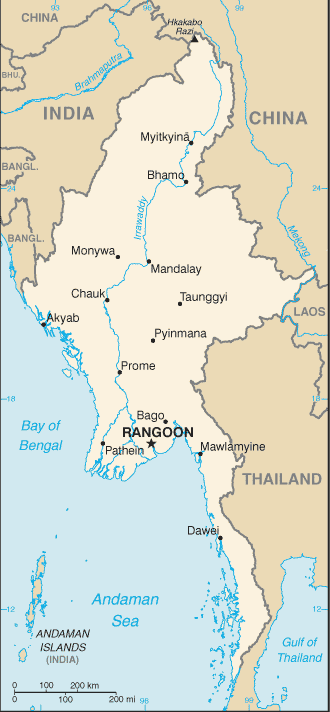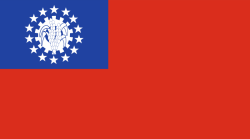Union of Myanmar
Related Categories:
 Myanmar Language
Myanmar LanguageMyanmar script draws its source from Brahmi script which flourished in India from about 500 B.C. to over 300 AD.
www.myanmars.net/
2:3 and 6:11 Variants of the National Flag, Meaning of the flag, Significant dates, National Emblem, President's Flag, River Patrol, Rangoon Port Commissioner.
www.fotw.us/
Myanmar, officially Union of Myanmar is the largest country by geographical area in mainland Southeast Asia. It is also known as Burma or the Union of Burma by many bodies and states which do not recognize the ruling military junta.
en.wikipedia.org/
A majority of Burma's estimated 54.3 million people are ethnic Burmans. Shans, Karens, Rohingya, Arakanese, Kachins, Chins, Mons, and many other smaller indigenous ethnic groups form about 30% of the population. Indians and Chinese are the largest non-indigenous groups.
Although Burmese is the most widely spoken language (approx. 32 million speakers), other ethnic groups have retained their own identities and languages. Some of the most prominent are Shan; various Karen, Karenni and Chin languages; Arakanese; Jingpho; Mon; Palaung; Parauk; Wa; and Yangbye. English is spoken in many areas frequented by tourists. The Indian and Chinese residents speak various languages and dialects of their homelands: Hindi, Urdu, Tamil, Bengali, Mandarin, Fujianese, and Cantonese.
According to the 1974 Constitution, Buddhism is the official religion of Burma. An estimated 89% of the population practices it. Other religions, Christian 4%--Baptist 3%, Roman Catholic 1%--Muslim 4%, and animist 1%, are less prevalent, although the regime may underestimate adherents of these other religions.
Much of the population lives without basic sanitation or running water. In 2000, the World Health Organization (WHO) ranked Burma among the lowest countries worldwide in healthcare delivery to its citizens. High infant mortality rates and short life expectancies further highlight poor health and living conditions. The HIV/AIDS epidemic poses a serious threat to the Burmese population, as do tuberculosis and malaria. In 2005, the UNDPís Human Development Index, which measures achievements in terms of life expectancy, educational attainment and adjusted real income, ranked Burma 129 out of 177 countries.
There are numerous documented human rights violations, and internal displacement of ethnic minorities also is prevalent. Several million Burmese, many of them ethnic minorities, have fled for economic and political reasons to Bangladesh, India, China, Malaysia and Thailand to seek work and asylum. More than 170,000 Burmese live in the nine refugee camps in Thailand and the two in Bangladesh. Over one million Burmese work and reside legally and illegally in the countries in the region.
www.state.gov/r/
Introduction
About
Contact
Symbols in The News
Interpret this Symbol
AAC
African
AI
Alchemy
Alphabets
Ancient
Animal Symbolism
Architecture
Art
Articles
Astrology
Baha'i
Blissymbolics
Blueprint Symbols
Buddhist
Celtic Symbols
Cemetery
Chinese Symbols
Christian
Circle
City
Codes
Color
Conlangs
Crop Circles
Danger
Da Vinci Code
Designing Logos
Dictionaries
Dreams
Education
Egyptian Symbols
Electrical
Emoticons
Find Images
Fonts
Food
Fraternity
Hamsa
Healing
Heraldry
Hermetic
Highway Signs
Hindu
History
Hobo
Holiday
Icons
iConji
Islamic
Jain Symbols
Japanese, Kanji
Jewish
Justice
Law
Literary Symbolism
Mandalas
Map
Masonic
Math, Number
Meaning of Names
Medical
Middle East
Military
Miscellaneous
Money
Music
Mythology
Native American
Playing Cards
Power
Psychology
QiQiiKhu
Reiki
Religious
Runes, Norse
Sacred Geometry
Scientific
Science Fiction
Sorority
Sports
Symbols in the News
Tattoos
ThirteenSymbols
Tree of Life
Ursprache
Videos
Visual Languages
Weather
Web Codes
Wicca
Words
Writing Systems
Braille
Coinherence
Coptic
Cuneiform
Easter Island
Etruscan
Happy Human
Hebrew
Kokopelli
Linear B
Lotus
Love Symbols
Mandorla
Moon Alphabet
Nine Pointed Star
Om
Oz
Phonetic
Scarab Beetle
Silent
Theosophy
Unifon
About
Contact
Symbols in The News
Interpret this Symbol
AAC
African
AI
Alchemy
Alphabets
Ancient
Animal Symbolism
Architecture
Art
Articles
Astrology
Baha'i
Blissymbolics
Blueprint Symbols
Buddhist
Celtic Symbols
Cemetery
Chinese Symbols
Christian
Circle
City
Codes
Color
Conlangs
Crop Circles
Danger
Da Vinci Code
Designing Logos
Dictionaries
Dreams
Education
Egyptian Symbols
Electrical
Emoticons
Find Images
Fonts
Food
Fraternity
Hamsa
Healing
Heraldry
Hermetic
Highway Signs
Hindu
History
Hobo
Holiday
Icons
iConji
Islamic
Jain Symbols
Japanese, Kanji
Jewish
Justice
Law
Literary Symbolism
Mandalas
Map
Masonic
Math, Number
Meaning of Names
Medical
Middle East
Military
Miscellaneous
Money
Music
Mythology
Native American
Playing Cards
Power
Psychology
QiQiiKhu
Reiki
Religious
Runes, Norse
Sacred Geometry
Scientific
Science Fiction
Sorority
Sports
Symbols in the News
Tattoos
ThirteenSymbols
Tree of Life
Ursprache
Videos
Visual Languages
Weather
Web Codes
Wicca
Words
Writing Systems
Braille
Coinherence
Coptic
Cuneiform
Easter Island
Etruscan
Happy Human
Hebrew
Kokopelli
Linear B
Lotus
Love Symbols
Mandorla
Moon Alphabet
Nine Pointed Star
Om
Oz
Phonetic
Scarab Beetle
Silent
Theosophy
Unifon

